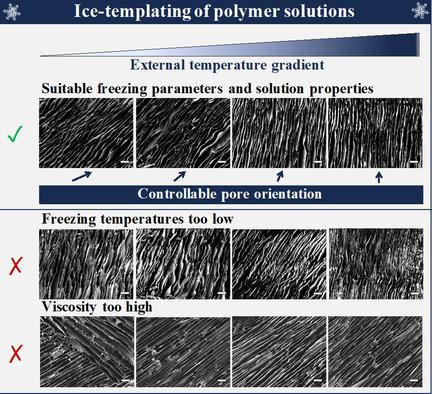当前位置:
X-MOL 学术
›
Adv. Eng. Mater.
›
论文详情
Our official English website, www.x-mol.net, welcomes your
feedback! (Note: you will need to create a separate account there.)
Morphological Control of Freeze-Structured Scaffolds by Selective Temperature and Material Control in the Ice-Templating Process
Advanced Engineering Materials ( IF 3.4 ) Pub Date : 2021-08-19 , DOI: 10.1002/adem.202100860 Annika Seifert 1 , Julia Gruber 1 , Uwe Gbureck 1 , Jürgen Groll 1
Advanced Engineering Materials ( IF 3.4 ) Pub Date : 2021-08-19 , DOI: 10.1002/adem.202100860 Annika Seifert 1 , Julia Gruber 1 , Uwe Gbureck 1 , Jürgen Groll 1
Affiliation

|
Herein, it is aimed to highlight the importance of the process parameter choice during directional solidification of polymer solutions, as they have a significant influence on the pore structure and orientation. Biopolymer solutions (alginate and chitosan) are directionally frozen, while systematically varying parameters such as the external temperature gradient, the temperature of the overall system, and the temperatures of the cooling surfaces. In addition, the effect of material properties such as molecular weight, solution concentration, or viscosity on the sample morphology is investigated. By selecting appropriate temperature gradients and cooling surface temperatures, aligned pores ranging in size between (50 ± 22) μm and (144 ± 56) μm are observed in the alginate samples, whereas the pore orientation is influenced by altering the external temperature gradient. As this gradient increases, the pores are increasingly oriented perpendicular to the sample surface. This is also observed in the chitosan samples. However, if the overall system is too cold, that is, using temperatures of the lower cooling surface down to −60 °C combined with low temperatures of the upper cooling surface, control over pore orientation is lost. This is also found when viscosity of chitosan solutions is above ≈5 Pas near the freezing point.
中文翻译:

冰模板过程中通过选择性温度和材料控制对冻结结构支架的形态控制
本文旨在强调聚合物溶液定向凝固过程中工艺参数选择的重要性,因为它们对孔结构和取向有显着影响。生物聚合物溶液(藻酸盐和壳聚糖)被定向冷冻,同时系统地改变外部温度梯度、整个系统的温度和冷却表面的温度等参数。此外,还研究了诸如分子量、溶液浓度或粘度等材料特性对样品形态的影响。通过选择合适的温度梯度和冷却表面温度,在海藻酸盐样品中观察到尺寸在 (50 ± 22) μm 和 (144 ± 56) μm 之间的排列孔,而孔取向受改变外部温度梯度的影响。随着该梯度的增加,孔越来越垂直于样品表面。这也在壳聚糖样品中观察到。但是,如果整个系统过冷,即使用低至 -60 °C 的下冷却表面的温度以及上冷却表面的低温,则会失去对孔取向的控制。当壳聚糖溶液的粘度在冰点附近高于约 5 Pas 时,也会发现这种情况。使用低至-60°C的下冷却表面的温度结合上冷却表面的低温,失去了对孔取向的控制。当壳聚糖溶液的粘度在冰点附近高于约 5 Pas 时,也会发现这种情况。使用低至-60°C的下冷却表面的温度结合上冷却表面的低温,失去了对孔取向的控制。当壳聚糖溶液的粘度在冰点附近高于约 5 Pas 时,也会发现这种情况。
更新日期:2021-08-19
中文翻译:

冰模板过程中通过选择性温度和材料控制对冻结结构支架的形态控制
本文旨在强调聚合物溶液定向凝固过程中工艺参数选择的重要性,因为它们对孔结构和取向有显着影响。生物聚合物溶液(藻酸盐和壳聚糖)被定向冷冻,同时系统地改变外部温度梯度、整个系统的温度和冷却表面的温度等参数。此外,还研究了诸如分子量、溶液浓度或粘度等材料特性对样品形态的影响。通过选择合适的温度梯度和冷却表面温度,在海藻酸盐样品中观察到尺寸在 (50 ± 22) μm 和 (144 ± 56) μm 之间的排列孔,而孔取向受改变外部温度梯度的影响。随着该梯度的增加,孔越来越垂直于样品表面。这也在壳聚糖样品中观察到。但是,如果整个系统过冷,即使用低至 -60 °C 的下冷却表面的温度以及上冷却表面的低温,则会失去对孔取向的控制。当壳聚糖溶液的粘度在冰点附近高于约 5 Pas 时,也会发现这种情况。使用低至-60°C的下冷却表面的温度结合上冷却表面的低温,失去了对孔取向的控制。当壳聚糖溶液的粘度在冰点附近高于约 5 Pas 时,也会发现这种情况。使用低至-60°C的下冷却表面的温度结合上冷却表面的低温,失去了对孔取向的控制。当壳聚糖溶液的粘度在冰点附近高于约 5 Pas 时,也会发现这种情况。











































 京公网安备 11010802027423号
京公网安备 11010802027423号